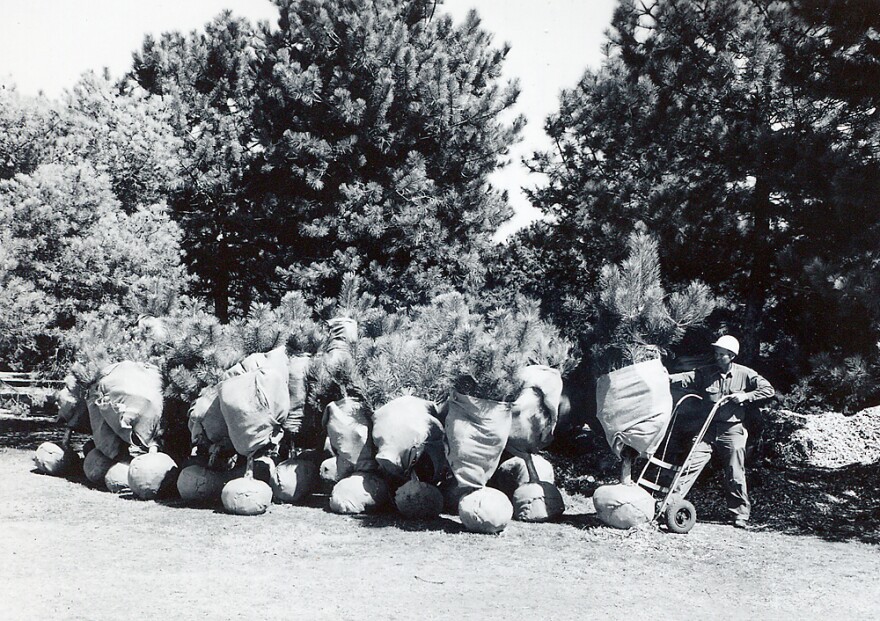One of the most drawn out impacts of extreme drought is seen in the form of dying trees. The Wichita Parks Department estimates that since 2011, for every 10 trees lost on city property, only one has been planted. KMUW’s Sean Sandefur reports…
When you think about planting trees, you might have images of spring in your mind's eye. Tulips starting to bud and heavy coats thankfully stowed away in an attic. But, that’s not really the case.
With about two inches of snow on the ground and temperatures in the mid-teens, crews for the Wichita Parks Department are busy at the city’s greenhouse and nursery, which were both built in Linwood Park in 1935. The greenhouse is a long, brick building with panes of fiberglass as its roof.
“All of these trees have been delivered in the past two months,” City Arborist Gary Farris says.
He looks out over big piles of mulch--three feet high. They hold various kinds of trees. He says winter is the best time for planting them because the trees are less prone to shock when they’re replanted.

These trees are destined for various public properties throughout Wichita. The city used to grow many of it’s own flowers and trees, but now purchase nearly all of them because it’s more cost effective.
Farris explains what the workers here do.
“We call this our reforestation group," he says. "One of our main focuses is to replace trees that have died, either from natural causes, storm damage or from some defect.”
A group of four people, not including Farris, are responsible for the estimated 350,000 trees spread throughout public land in Wichita. Tree removal and tree planting are daily chores for this group. Sometimes, a car wreck will take a tree out, but over the past several years, drought has been their worst enemy.

“I'll put it into perspective," he says. "We have planted, on average, 500 trees a year since 2011. We've lost 20,000.”
About a decade ago, the city was planting as many as 1,500 trees a year, but Farris says due to the recession and budget cuts, they now rely on donated funds to keep young trees on hand for planting.
“That is a significant problem when you look at the benefits that trees provide," he says. "Trees clean our air, they sequester carbon, and they help us filter particulates out of the air.
"Not to mention the storm water sequestration," he adds. "We’re losing out.”

The solution seems easy: plant more trees and Wichita’s air will be cleaner. But, Farris says it’s not that simple. Even if the city could afford to buy more trees, he doesn’t have the manpower to plant them. He says the city needs to plant 40,000 to 50,000 trees in the near future just to catch up.
He's not holding his breath for more money or more staff.
“I don't want to be a Debbie Downer," Farris says. "I think that we have a real potential to get back to those levels, but it's going to be private efforts, volunteer efforts and private funds.”
There is hope for Wichita's trees, and much of it lies with a group that’s just beginning to take shape. Barney Barnhard calls his new organization ICTrees. He says it all started last fall when he took a master gardeners class at the Sedgwick County Extension Office in Wichita.
“One of the leaders of the extension service is a tree advocate," Barnhard says. "He mentioned that the city was losing about 20,000 trees due to drought. And that just seemed like an extraordinary number to me.”

He’s since met with city officials to see what volunteers can do to help repopulate Wichita’s tree canopy. There’s no data for how many private trees have died over the years, but he says they're facing the same harsh conditions as those trees planted on city property. According to Barnhard, the key to seeing more trees sprouting up in Wichita is to educate the public on what they can provide.
“You could plant two or three deciduous trees (those that lose their leaves in the winter) strategically around your house, and you could save up to 30 percent of your energy bills," he says. "So, there are some real environmental benefits to having trees.”
He does have one big concern, however. While it may be attractive to help plant trees, caring for them is another story.
“There are lots of civic groups that would come out and spend a day planting trees," he says. "We could easily plant 200 to 300 trees in a day. But then you've got to find somebody who's willing to water those trees for the next two years. So, that's the bigger obstacle we face right now.”

Barnhard’s says the purpose of ICTrees is to find a core group of devoted members who both encourage people to plant trees on their own property, and plant and take care of trees on public property.
“What I would like to get to is a long-term, endowed program that would take-in $100,000 to $200,000 a year just for tree planting," he says. "That's a pretty ambitious goal, and it'll take a couple of years to gain momentum. But, if we don't start, it'll never happen.”

ICTrees will make its formal debut at the Outdoor Living and Landscape show at Century II next weekend. Barnhard says he’ll be making a presentation, hoping his message will resonate with people and lead to thousands of trees being planted in Wichita.
To contact KMUW News or to send in a news tip, reach us at news@kmuw.org.
Follow Sean Sandefur on Twitter, @SeanSandefur


